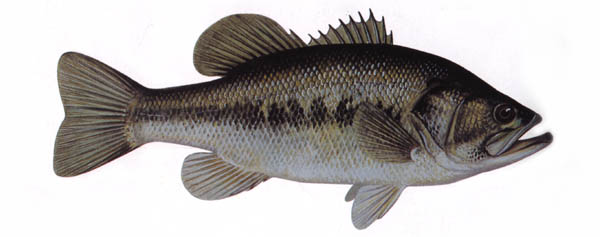
Micropterus salmoides
Bigmouth bass, black bass, Florida bass, Florida largemouth, green bass, northern largemouth
The upper jaw of the largemouth bass extends beyond its eye, making it easily distinguishable from its relatives. There is an obvious, deep notch that almost separates the first and second dorsal fins. There are no scales on the second, soft-rayed dorsal fin (12-13 rays). Its back is usually a dark green color, while lighter green on the sides and silvery on the belly. A dark horizontal band lines the entire length of the body, although this band maybe become difficult to distinguish on older fish.
A largemouth bassí diet depends on its age. The young feed on copepods, waterfleas, small insect larvae, and microscopic animals such as zooplankton. When they reach 1-2 inches in length they begin to feed on small fish and insects. Adult largemouth bass are the primary predator in many lakes, feeding on other fish, crayfish, aquatic insects, frogs, crabs, mice, and even fallen birds.
Now found throughout the entire U.S. (except Alaska), as well as southern Canada and northern Mexico.
Largemouth bass prefer mostly clear, non-flowing waters such as ponds, lakes, and reservoirs with sandy shorelines, but can also be found in slow, calm streams. They tend to stay where vegetation is available for food and cover. They tend to be found at depths less than 20 feet, and favor water temperatures of 65 to 85 degrees.
Largemouth bass grow to 10-13 inches and 2-3 lbs in about 4 years. Males can reach about 16 inches while females can surpass 22 inches. The oldest recorded largemouth bass was 16 years old, and the typical trophy bass (10 lbs) is about 10 years old.
22 pounds, 4 ounces (Source - IGFA)